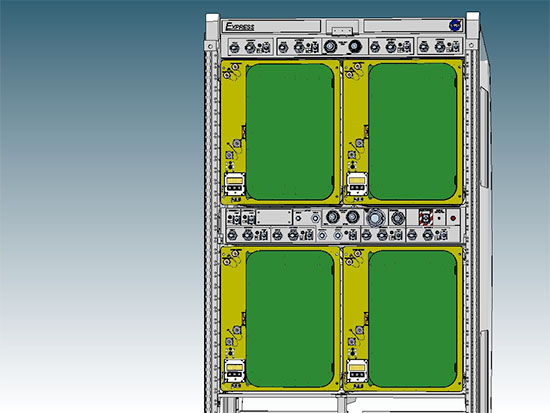Media contact: Tyler Greer, tgreer@uab.edu
 This conceptual drawing of Iceberg shows the modular nature of the units. Unlike MELFI's permanent structure, these units can be removed from the rack and returned to earth in the event that they ever need repairs or refurbishing.NASA has a plan for the future of space research, and it is counting on University of Alabama at Birmingham engineers to help make it a reality.
This conceptual drawing of Iceberg shows the modular nature of the units. Unlike MELFI's permanent structure, these units can be removed from the rack and returned to earth in the event that they ever need repairs or refurbishing.NASA has a plan for the future of space research, and it is counting on University of Alabama at Birmingham engineers to help make it a reality.
The UAB Engineering Innovation and Technology Development research group recently received a contract worth $6.2 million over the next three years to design and build a new set of freezers for the International Space Station.
“NASA is looking ahead to continuing scientific experiments through 2024 and beyond, so they were looking at options for a long-term.”” said EITD scientist Daniel Connor.
To meet its goals, NASA looked to the EITD—an award-winning team with extensive experience in exactly this type of project. For more than a decade, the EITD team has designed, built and maintained several models of high-tech space freezers for the ISS, including the MERLIN, Glacier, and Polar units. “Glacier and Polar were designed to be transport devices,” said Senior Mechanical Engineer Lance Weise. “This new unit will be permanently in orbit on the ISS. We’ll use some aspects from those previous projects, but this will be a whole new system.”
Building a better iceberg
EITD director Lee Moradi, Ph.D., says his team’s design for a new unit, dubbed “Iceberg,” will include modifications that will protect against a number of contingencies. For one, the Iceberg units will be modular, with four individual units operating independently from one another on one rack. “If one unit goes down,” Moradi said, “the other three are working, and individual units can be replaced or brought back and refurbished, if needed, without too much disruption.”
As far as day-to-day operations, the Iceberg unit will provide additional capabilities. “One of the requirements is that we have an eight-hour hold time for the samples,” said David Ray, Project Manager for Iceberg. “They don’t want to interrupt the crew’s sleep cycle, so if there is a loss of power to a unit for any reason, the unit needs to be able to maintain its temperature for eight hours.”
To achieve that, a number of EITD team members went to work to design an improved inner cold volume that can keep the samples at temperatures as low as minus 85 degrees. “Iceberg uses a cold volume that is a box within a box,” Ray explained. “The Inner Cold Volume is the interior structure that provides support for the samples, along with a large thermal mass which significantly increases the hold time of the unit.”
Other challenges include strict acoustical requirements that result in significant work to make the units run quieter without sacrificing performance.
In all, the team will build seven units: four will be in use on the ISS, plus two backups and one qualification unit. The qualification unit will be kept at Johnson Space Center for training.
The EITD team expects to deliver a qualification unit to NASA within 12 to 14 months, with the goal of having units in orbit within two years.
To meet its goals, NASA looked to the EITD—an award-winning team with extensive experience in exactly this type of project. For more than a decade, the EITD team has designed, built and maintained several models of high-tech space freezers for the ISS, including the MERLIN, Glacier, and Polar units. “Glacier and Polar were designed to be transport devices,” said Senior Mechanical Engineer Lance Weise. “This new unit will be permanently in orbit on the ISS. We’ll use some aspects from those previous projects, but this will be a whole new system.”